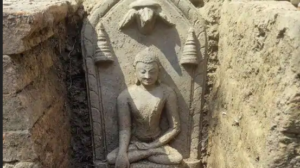
As per the evidence found in Hazaribagh, it appeared that the Buddhist structures were built during the Pala period, said an archaeologist with the ASI.
A 10th century structure resembling a small ‘Buddha Vihar’ (Buddhist shrine-cum-monastery) has been discovered during an excavation, being carried out by Archeological Survey of India (ASI), in foothills of Juljul hill at Sadar block of Hazaribagh district, around 110-km from capital Ranchi, ASI officials said on Tuesday.
The ASI identified three mounds in the foothills having links to Buddhism last year. The excavation of the first mound last year led to the discovery of a complete shrine with a central and two subsidiary shrines, just two metres below the surface. However, the excavation work was suspended after two months due to Covid-19 pandemic triggered lockdowns and some other reasons.
In the second round of excavation, beginning the last week of January this year, the second mound, around 40-meters away from the first mound or central shrine, was excavated and a small Buddha Vihar like structure was discovered.
“We started excavation in the second mound of the area in January last week, where a huge structural mound, similar to a small Buddha Vihar, was found with three cells (rooms). In the west corner of the structure, we found five sculptures of Gautam Buddha in seated position and one sculpture of Tara, which indicates that it might also be a centre of Vajrayana,” said Dr Neeraj Mishra, assistant archaeologist at ASI.
Spread over a 50-metre long and 50-metre wide area, three cells and hoards of artefacts including statues of Gautam Budha and Tara, the female Bodhisattva in Mahayana Buddhism who appears as a female Buddha in Vajrayana Buddhism, were discovered.
“As per the evidence found here, it appeared that the structures had been built during the Pala period. During the excavation, we found an inscription on a stone slab. The paleographic dating of the inscription suggests that it was of 10th century AD, meaning the Pala period,” said Dr Mishra.
It might have been a big religious centre then, as it is located on the side of the old Grand Trunk road, connecting Sarnath in Uttar Pradesh to Bihar, home to historic Bodh Gaya where Buddha attained salvation, he added.
He recalled that a shrine and two subsidiary shrines, spread over 30 metres long and 50 metres wide area, were discovered last year. “It was a single storey temple. An entry gate and stairs were also found there.”
Historians and archaeologists find the discovery of great importance, which will help understand the history and influence of the dynasty in Jharkhand.
Historian Dr DN Ojha, dean, social sciences department at Ranchi University, said ancient history talks about the arrival of Buddhist monks in this area and the extension of Buddhism’s reach here.
“However, there was also a debate on this. The recent discovery in Hazaribag would work as a big evidence to support the theory of extension of Buddhism and arrival of monks here,” he added.




